Processing of Water Treatment Sludge by Bioleaching
Abstract
:1. Introduction
2. Materials and Methods
2.1. Materials
2.2. Inoculum Preparation
2.3. Bioleaching Experiments
2.4. Analysis
2.5. Statistical Analysis
3. Results and Discussion
3.1. Changes in pH and Oxidation-Reduction Potential during Study
3.2. The Removal of Heavy Metals during the Bioleaching
3.3. Mass Balance in Bioleaching
3.4. Statistical Analysis
4. Conclusions
Author Contributions
Funding
Conflicts of Interest
References
- Ahmad, T.; Ahmad, K.; Alam, M. Characterization of water treatment plant’s sludge and its safe disposal options. Procedia Environ. Sci. 2016, 35, 950–955. [Google Scholar] [CrossRef]
- Keeley, J.; Smith, A.D.; Judd, S.J.; Jarvis, P. Reuse of recovered coagulants in water treatment: An investigation on the effect coagulant purity has on treatment performance. Sep. Purif. Technol. 2014, 131, 69–78. [Google Scholar] [CrossRef] [Green Version]
- Marousek, J.; Stehel, V.; Vochozka, M.; Kolar, L.; Marouskova, A.; Strunecký, O.; Peterka, J.; Kopecký, M.; Shreedhar, S. Ferrous sludge from water clarification: Changes in waste management practices advisable. J. Clean. Prod. 2019, 218, 459–464. [Google Scholar] [CrossRef]
- Cremades, L.; Cusido, J.A.; Arteaga, F. Recycling of sludge from drinking water treatment as ceramic material for the manufacture of tiles. J. Clean. Prod. 2018, 201, 1071–1080. [Google Scholar] [CrossRef]
- Mymrin, V.; Hackbart, F.M.; Alekseev, K.; Avancim, M.A.; Winter, E., Jr.; Marinho, G.P.; Iarozinski, A.N.; Catai, R.E. Construction materials wastes use to neutralize hazardous municipal water treatment sludge. Construct. Build. Mater. 2019, 204, 800–808. [Google Scholar] [CrossRef]
- Ling, Y.P.; Tham, R.-H.; Lim, S.-M.; Fahim, M.; Ooi, C.-H.; Krishnan, P.; Matsumoto, A.; Yeoh, F.-Y. Evaluation and reutilization of water sludge from fresh water processing plant as a green clay substituent. Appl. Clay Sci. 2017, 143, 300–306. [Google Scholar] [CrossRef]
- Gastaldini, A.L.G.; Hengen, M.F.; Gastaldini, M.C.C.; Amaralm, F.D.; Antolini, M.B.; Coletto, T. The use of water treatment plant sludge ash as a mineral addition. Construct. Build. Mater. 2015, 94, 513–520. [Google Scholar] [CrossRef]
- Carvalho Gomes, S.; Zhou, J.L.; Li, W.; Long, G. Progress in manufacture and properties of construction materials incorporating water treatment sludge: A review. Resour. Conserv. Recycl. 2019, 145, 148–159. [Google Scholar] [CrossRef]
- Ferone, C.; Capasso, I.; Bonati, A.; Roviello, G.; Montagnaro, F.; Santoro, L.; Turco, R.; Cioffi, R. Sustainable management of water potabilization sludge by means of geopolymers production. J. Clean. Prod. 2019, 229, 1–9. [Google Scholar] [CrossRef]
- Guan, X.-H.; Chen, G.-H.; Shang, C. Re-use of water treatment works sludge to enhance particulate pollutant removal from sewage. Water Res. 2005, 39, 3433–3440. [Google Scholar] [CrossRef]
- Ahmad, T.; Ahmad, K.; Ahad, A.; Alam, M. Characterization of water treatment sludge and its reuse as coagulant. J. Environ. Manag. 2016, 182, 606–611. [Google Scholar] [CrossRef] [PubMed]
- Bal Krishna, K.C.; Aryal, A.; Jansen, T. Comparative study of ground water treatment plants sludges to remove phosphorous from wastewater. J. Environ. Manag. 2016, 180, 17–23. [Google Scholar] [CrossRef] [PubMed]
- Al-Tahmazi, T.; Babatundea, A.O. Mechanistic study of P retention by dewatered waterworks sludges. Environ. Technol. Innov. 2016, 6, 38–48. [Google Scholar] [CrossRef]
- Keeley, J.; Smith, A.D.; Judd, S.J.; Jarvis, P. Acidified and ultrafiltered recovered coagulants from water treatment works sludge for removal of phosphorus from wastewater. Water Res. 2016, 88, 380–388. [Google Scholar] [CrossRef] [Green Version]
- Keeley, J.; Jarvis, P.; Smith, A.D.; Judd, S.J. Coagulant recovery and reuse for drinking water treatment. Water Res. 2016, 88, 502–509. [Google Scholar] [CrossRef] [Green Version]
- Asada, L.N.; Sundefeld, G.C.; Alvarez, C.R.; Ferreira Filho, S.S.; Pivelli, R.P. Water treatment plant sludge discharge to wastewater treatment plant works: Effects on the operation of upflow anareobic sludge blanket reactor and activated sludge systems. Water Environ. Res. 2010, 82, 392–400. [Google Scholar] [CrossRef]
- Nair, A.T.; Ahammed, M.M. The reuse of water treatment sludge as a coagulant for post-treatment of UASB reactor treating urban wastewater. J. Clean. Prod. 2015, 96, 272–281. [Google Scholar] [CrossRef]
- Luiz, M.A.; Sidney Seckler, F.F.; Passos, P.R. Full-scale effects of addition of sludge from water treatment stations into processes of sewage treatment by conventional activated sludge. J. Environ. Manag. 2018, 215, 283–293. [Google Scholar]
- Li, J.; Liu, L.; Liu, J.; Ma, T.; Yan, A.; Ni, Y. Effect of adding alum sludge from water treatment plant on sewage sludge dewatering. J. Environ. Chem. Eng. 2016, 4, 746–752. [Google Scholar] [CrossRef]
- Ebrahimi-Nik, M.; Heidari, A.; Azghandi, S.R.; Mohammadi, F.A.; Younesi, H. Drinking water treatment sludge as an effective additive for biogas production from food waste; kinetic evaluation and biomethane potential test. Bioresour. Technol. 2018, 260, 421–426. [Google Scholar] [CrossRef]
- Shahin, S.A.; Mossad, M.; Fouad, M. Evaluation of copper removal efficiency using water treatment sludge. Water Sci. Eng. 2019, 12, 37–44. [Google Scholar] [CrossRef]
- Sanchis, R.; Dejoz, A.; Vazquez, I.; Vilarrasa-García, E.; Jimenez-Jimenez, J.; Rodríguez-Castellon, E.; Lopez Nieto, J.M.; Solsona, B. Ferric sludge derived from the process of water purification as an efficient catalyst and/or support for the removal of volatile organic compounds. Chemosphere 2019, 219, 286–295. [Google Scholar] [CrossRef] [PubMed]
- Jerez, C.A. Metal Extraction and Biomining. In Encyclopedia of Microbiology, 3rd ed.; Elsevier Inc.: Amsterdam, The Netherlands, 2009; pp. 407–420. [Google Scholar]
- Babel, S.; del Mundo, D.D. Heavy metal removal from contaminated sludge for land application: A review. Waste Manag. 2006, 26, 988–1004. [Google Scholar] [CrossRef]
- Johnson, D.B. Biomining-biotechnologies for extracting and recovering metals from ores and waste materials. Curr. Opin. Biotechnol. 2014, 30C, 24–31. [Google Scholar] [CrossRef] [PubMed]
- Peng, G.; Tian, G.; Liu, J.; Bao, Q.; Zang, L. Removal of heavy metals from sewage sludge with a combination of bioleaching and electrokinetic remediation technology. Desalination 2011, 271, 100–104. [Google Scholar] [CrossRef]
- Pathak, A.; Dastidar, M.G.; Sreekrishnan, T.R. Bioleaching of heavy metals from sewage sludge: A review. J. Environ. Manag. 2009, 90, 2343–2353. [Google Scholar] [CrossRef] [PubMed]
- Akcil, A.; Erust, C.; Ozdemiroglu, S.; Fonti, V.; Beolchini, F. A review of approaches and techniques used in aquatic contaminated sediments: Metal removal and stabilization by chemical and biotechnological processes. J. Clean. Prod. 2014, 86, 24–36. [Google Scholar] [CrossRef]
- Fonti, V.; Dell’Anno, A.; Beolchini, F. Does bioleaching represent a biotechnological strategy for remediation of contaminated sediments? Sci. Total Environ. 2016, 563–564, 302–319. [Google Scholar] [CrossRef]
- Baniasadi, M.; Vakilchap, F.; Bahaloo-Horeh, N.; Mousavi, S.M.; Farnaud, S. Advances in bioleaching as a sustainable method for metal recovery from e-waste: A review. J. Ind. Eng. Chem. 2019, 76, 75–90. [Google Scholar] [CrossRef]
- Hong, Y.; Valix, M. Bioleaching of electronic waste using acidophilic sulfur oxidising bacteria. J. Clean. Prod. 2014, 65, 465–472. [Google Scholar] [CrossRef]
- Funari, V.; Mäkinen, J.; Salminen, J.; Braga, R.; Dinelli, E.; Revitzer, H. Metal removal from Municipal Solid Waste Incineration fly ash: A comparison between chemical leaching and bioleaching. Waste Manag. 2017, 60, 397–406. [Google Scholar] [CrossRef] [PubMed]
- Gu, T.; Rastegar, S.O.; Mousavi, S.M.; Li, M.; Zhou, M. Advances in bioleaching for recovery of metals and bioremediation of fuel ash and sewage sludge. Bioresour. Technol. 2018, 261, 428–440. [Google Scholar] [CrossRef] [PubMed]
- Mishra, D.; Kim, D.-J.; Ralph, D.E.; Ahn, J.-H.; Rhee, Y.-H. Bioleaching of metals from spent lithium ion secondary batteries using Acidithiobacillus Ferrooxidans. Waste Manag. 2008, 28, 333–338. [Google Scholar] [CrossRef] [PubMed]
- Xin, B.; Zhang, D.; Zhang, X.; Xia, Y.; Wu, F.; Chen, S.; Li, L. Bioleaching mechanism of Co and Li from spent lithium-ion battery by the mixed culture of acidophilic sulphur-oxidizing and iron-oxidizing bacteria. Bioresour. Technol. 2009, 24, 6163–6169. [Google Scholar] [CrossRef] [PubMed]
- APHA. Standard Methods for the Examination of Water and Wastewater, 21st ed.; American Public Health Association/American Water Works Association/Water Environment Federation: Washington, DC, USA, 2005. [Google Scholar]
- Polish Committee for Standardization. Determination of Selected Elements by Means of Optical Emission Spectrometry with Inductively Excited Plasma (ICP-OES); PN-EN ISO 11885:2009; Polish Committee for Standardization: Warsaw, Poland, 2009. [Google Scholar]
- Zhang, P.; Zhu, Y.; Zhang, G.M.; Wu, Z. Sewage sludge bioleaching by indigenous sulfur-oxidizing bacteria: Effects of ratio of substrate dosage to solid content. Bioresour. Technol. 2009, 100, 1394–1398. [Google Scholar] [CrossRef] [PubMed]
- Li, Q.; Wang, C.; Li, B.; Sun, C.; Deng, F.; Song, C.; Wang, S. Isolation of Thiobacillus spp. and its application in the removal of heavy metals from activated sludge. Afr. J. Biotechnol. 2012, 11, 16336–16341. [Google Scholar] [CrossRef]
- Asghari, I.; Mousavi, S.M. Effects of key parameters in recycling of metals from petroleum refinery waste catalysts in bioleaching process. Rev. Environ. Sci. Biol. 2014, 13, 139–161. [Google Scholar] [CrossRef]
- Yu, R.; Shi, L.; Gu, G.; Zhou, D.; You, L.; Chen, M.; Qiu, G.; Zeng, W. The shift of microbial community under the adjustment of initial and processing pH during bioleaching of chalcopyrite concentrate by moderate thermophiles. Bioresour. Technol. 2014, 162, 300–307. [Google Scholar] [CrossRef]
- Christensen, T.H.; Kjeldsen, P.; Bjerg, P.L.; Jensen, D.L.; Christensen, B.J.; Baun, A.; Albrechtsen, H.; Heron, G. Biogeochemistry of landfill leachate plumes. Appl. Geochem. 2001, 16, 659–718. [Google Scholar] [CrossRef]
- Liu, H.H.; Sang, S.H. Study on the law of heavy metal leaching in municpal solid waste landfill. Environ. Monit. Assesss. 2010, 165, 349–363. [Google Scholar] [CrossRef] [PubMed]
- Kjeldsen, P.; Barlaz, M.A.; Rooker, A.P.; Baun, A.; Ledin, A.; Christensen, T.H. Present and Long-Term Composition of MSW Landfill Leachate: A review. Crit. Rev. Environ. Sci. Technol. 2002, 32, 297–336. [Google Scholar] [CrossRef]
- Bosecker, K. Bioleaching: Metal solubilization by microorganisms. FEMS Microbiol. Rev. 1997, 20, 591–604. [Google Scholar] [CrossRef]
- Nareshkumar, R.; Nagendran, R.; Parvathi, K. Bioleaching of heavy metals from contaminated soil using Acidithiobacillus thiooxidans: Effect of sulfur/soil ratio. World J. Microbiol. Biotechnol. 2008, 24, 1539–1546. [Google Scholar] [CrossRef]
- Xiang, L.; Chan, L.C.; Wong, J.W.C. Removal of heavy metals from anaerobically digested sewage sludge by isolated indigenous iron-oxidizing bacteria. Chemosphere 2000, 41, 283–287. [Google Scholar] [CrossRef]
- Seidel, A.; Zimmels, Y.; Armon, R. Mechanism of bioleaching of coal fly ash by Thiobacillus thiooxidans. Chem. Eng. J. 2001, 83, 123–130. [Google Scholar] [CrossRef]
- Mikkelsen, D.; Kappler, U.; McEwan, A.G.; Lindsay, I.S. Probing the archaeal diversity of a mixed thermophilic bioleaching culture by TGGE and FISH. Syst. Appl. Microbiol. 2009, 32, 501–513. [Google Scholar] [CrossRef] [PubMed]
- Rawlings, D.; Silver, S. Mining with microbes. Biotechnology 1995, 13, 773–778. [Google Scholar] [CrossRef]
- Krebs, W.; Brombacher, C.; Bosshard, P.P.; Bachofen, R.; Brandl, H. Microbial recovery of metals from solids. FEMS Microbiol. Rev. 1997, 20, 605–617. [Google Scholar] [CrossRef]
- Rawlings, D.E. Characteristics and adaptability of iron- and sulfur-oxidizing microorganisms used for the recovery of metals from minerals and their concentrates. Microb. Cell Fact. 2005, 4, 13. [Google Scholar] [CrossRef] [Green Version]
- Tsai, L.J.; Yu, K.C.; Chen, S.F.; Kung, P.Y.; Chang, C.Y.; Lin, C.H. Partitioning variation of heavy metals in contaminated river sediment via bioleaching: Effect of sulfur added to total solids ratio. Water Res. 2003, 37, 4623–4630. [Google Scholar] [CrossRef] [PubMed]
- Löser, C.; Zehnsdorf, A.; Görsch, K.; Seidel, H. Bioleaching of heavy metal polluted sediment: Kinetics of leaching and microbial sulfur oxidation. Eng. Life Sci. 2005, 5, 535–549. [Google Scholar] [CrossRef]
- Löser, C.; Zehnsdorf, A.; Hoffmann, P.; Seidel, H. Bioleaching of heavy metal polluted sediment: Influence of sediment properties (part 2). Eng. Life Sci. 2006, 6, 364–371. [Google Scholar] [CrossRef]
- Vera, M.; Schippers, A.; Sand, W. Progress in bioleaching: Fundamentals and mechanisms of bacterial metal sulfide oxidation—Part A. App. Microbiol. Biotechnol. 2013, 97, 7529–7541. [Google Scholar] [CrossRef] [PubMed]
- Rezza, I.; Salinasa, E.; Elorzaa, M.; Sanz de Tosettia, M.; Donatib, E. Mechanisms involved in bioleaching of an aluminosilicate by heterotrophic microorganisms. Process Biochem. 2001, 36, 495–500. [Google Scholar] [CrossRef]
- Vyas, S.; Ting, Y.P. Microbial leaching of heavy metals using Escherichia coli and evaluation of bioleaching mechanism. Bioresour. Technol. Rep. 2020, 9, 100368. [Google Scholar] [CrossRef]
- Vyas, S.; Ting, Y.P. Sequential biological process for molybdenum extraction from hydrodesulphurization spent catalyst. Chemosphere 2016, 160, 7–12. [Google Scholar] [CrossRef]

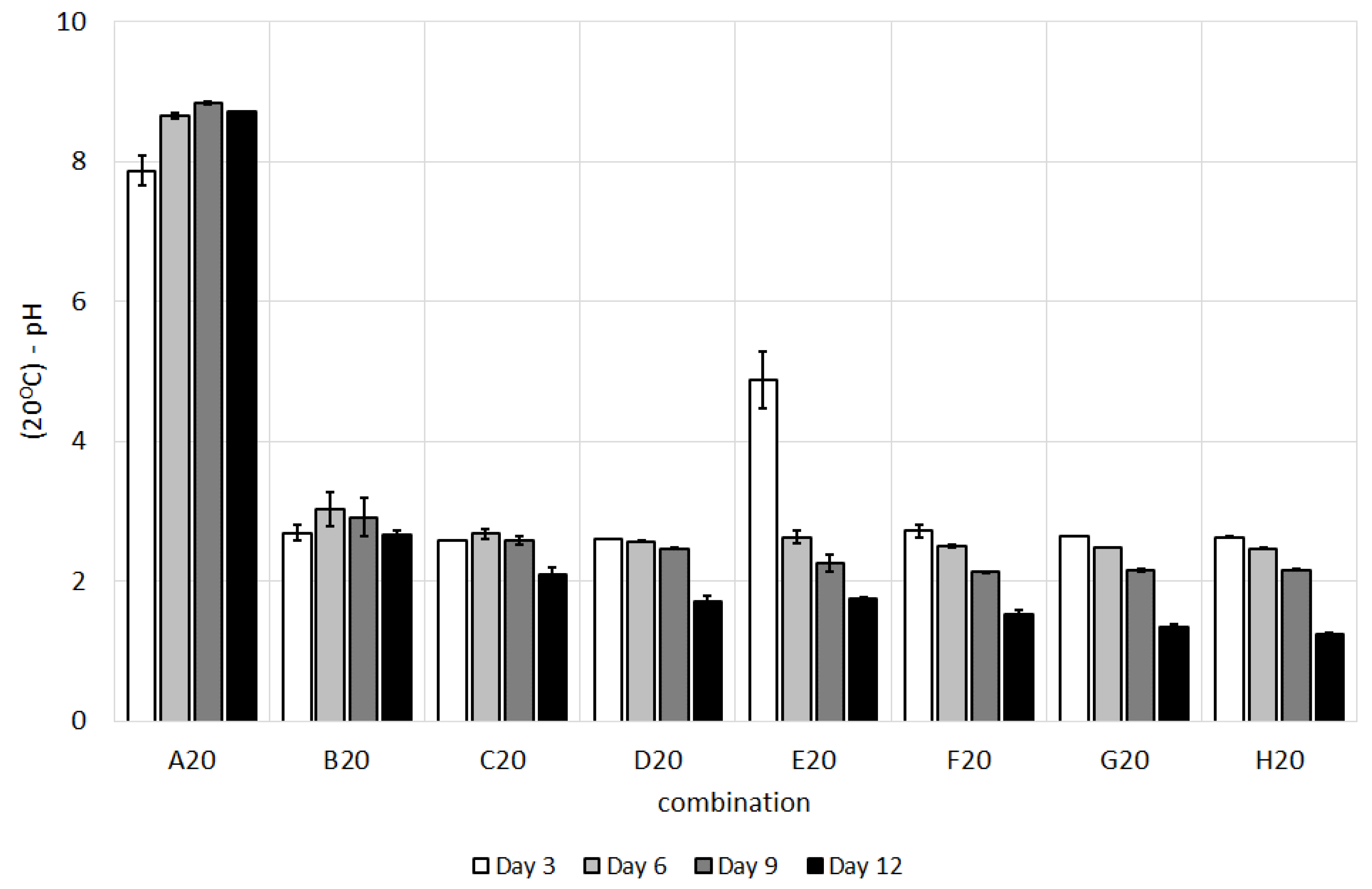
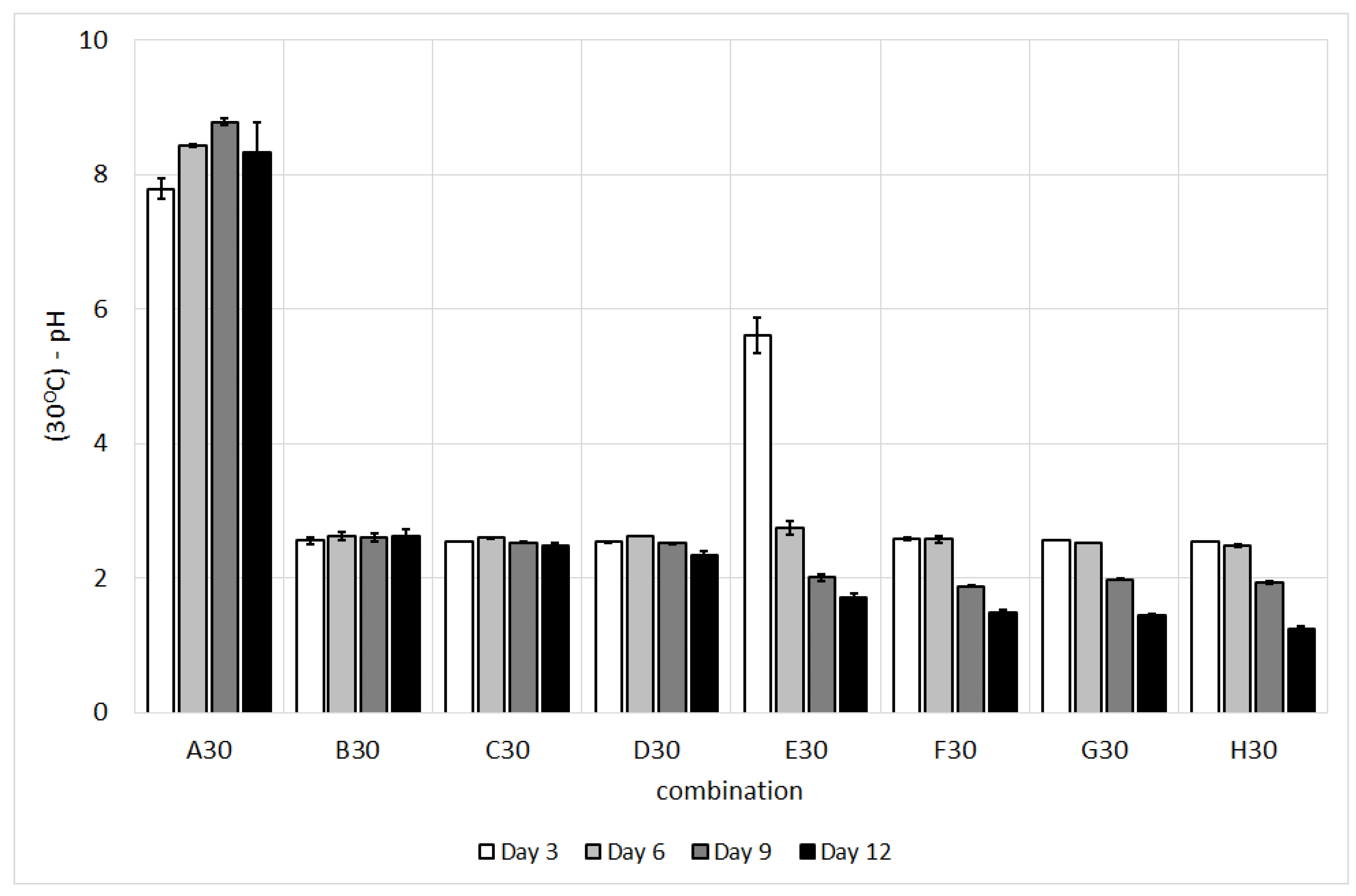
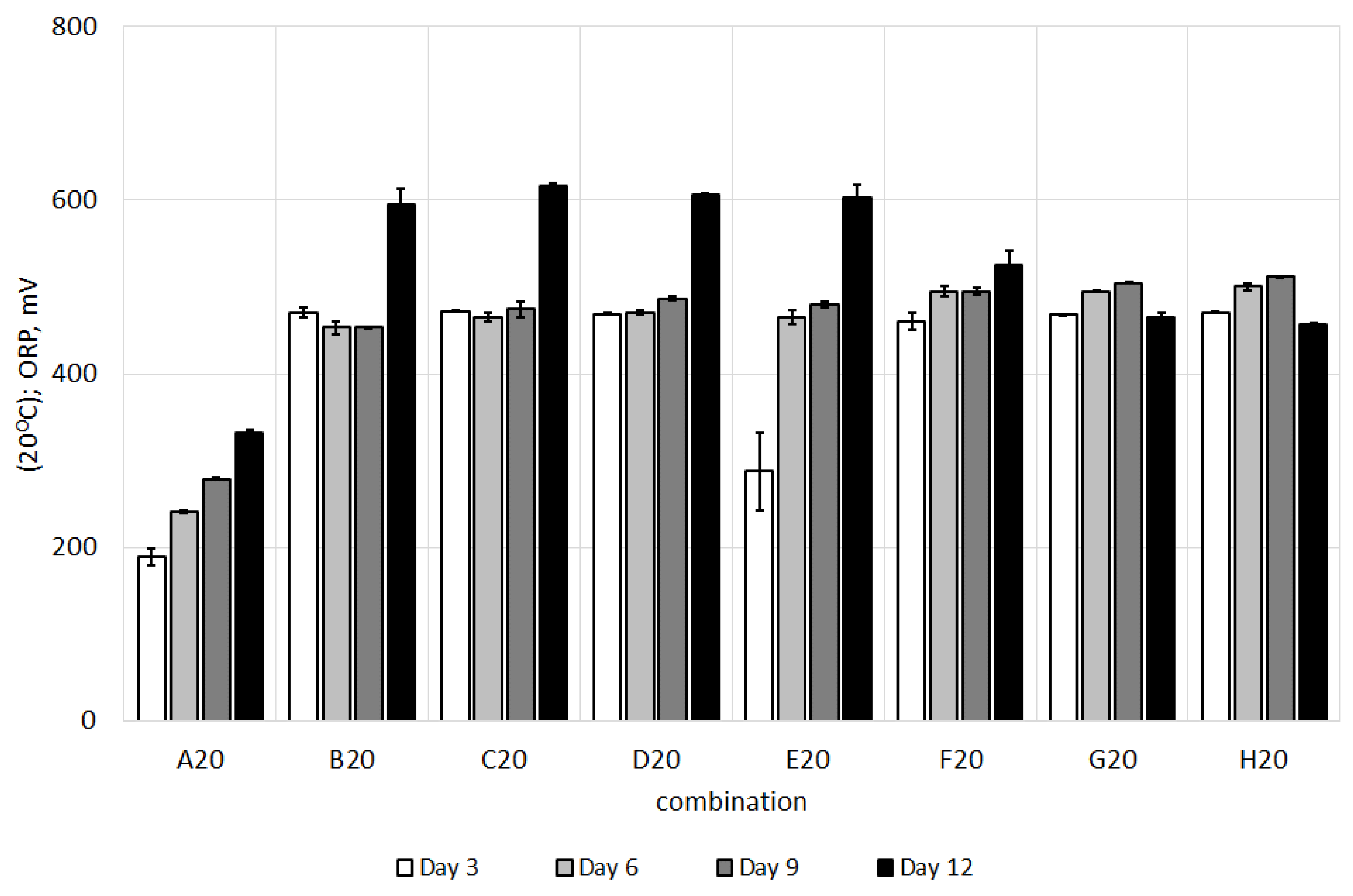


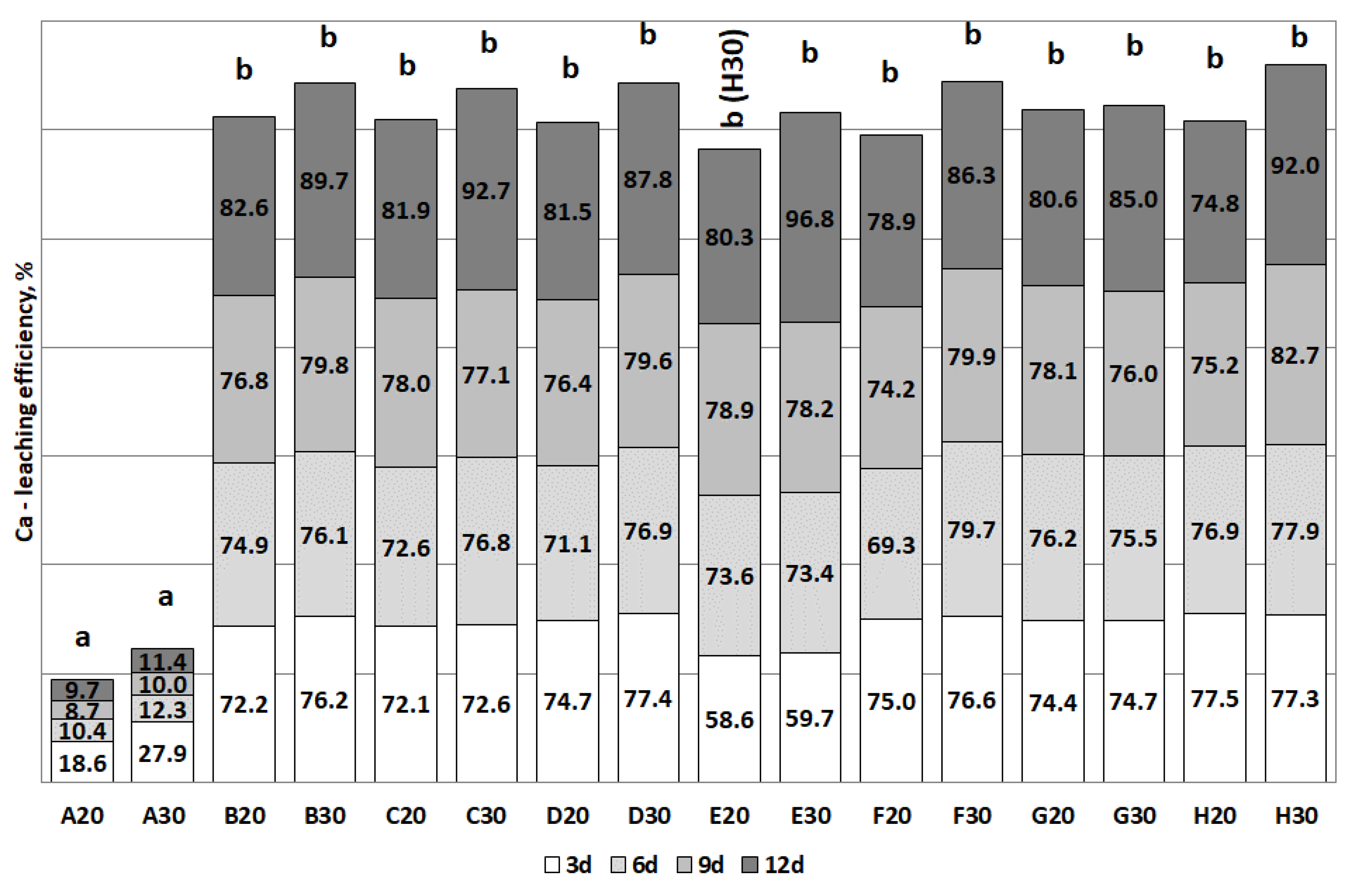

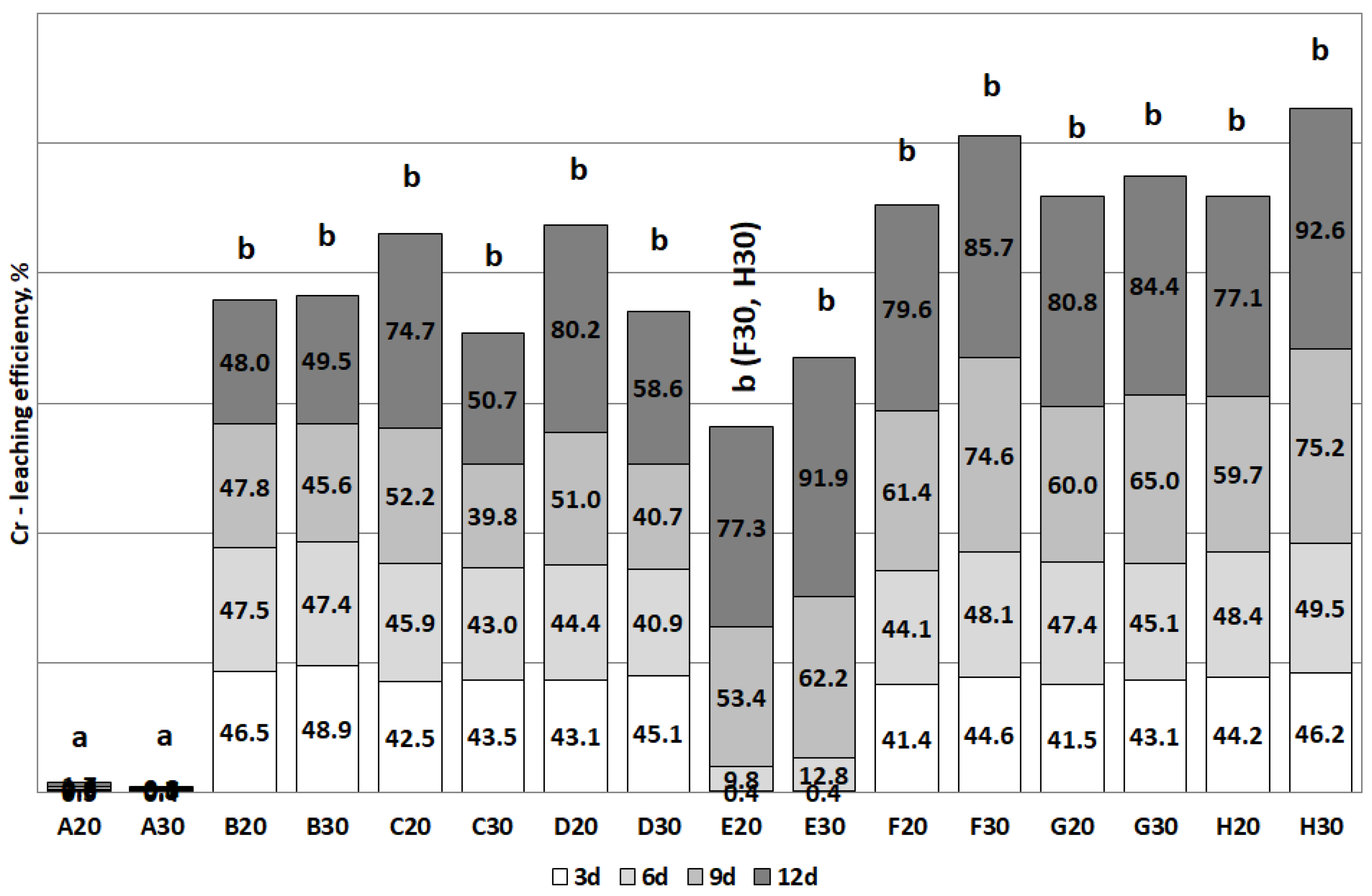


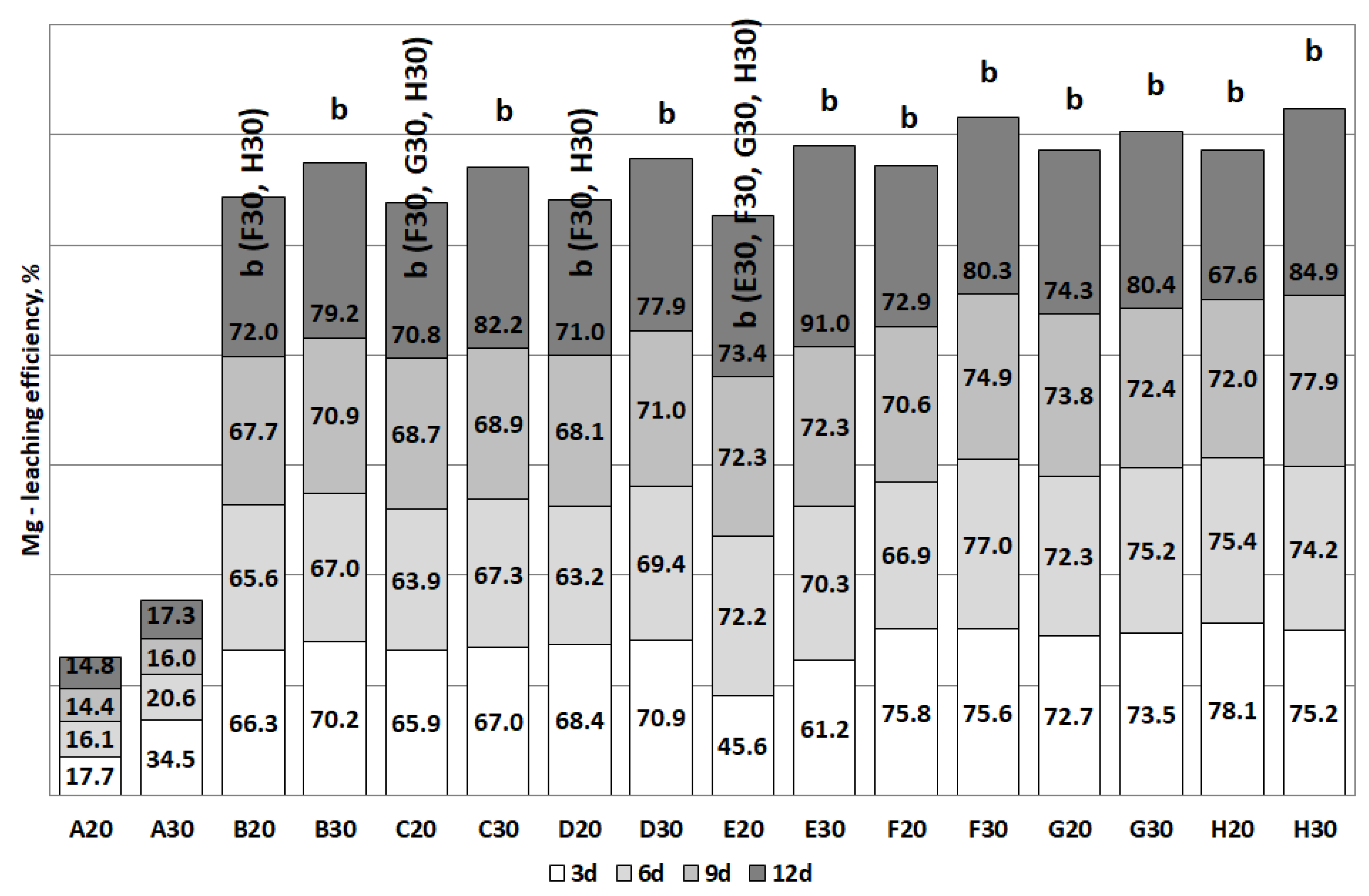


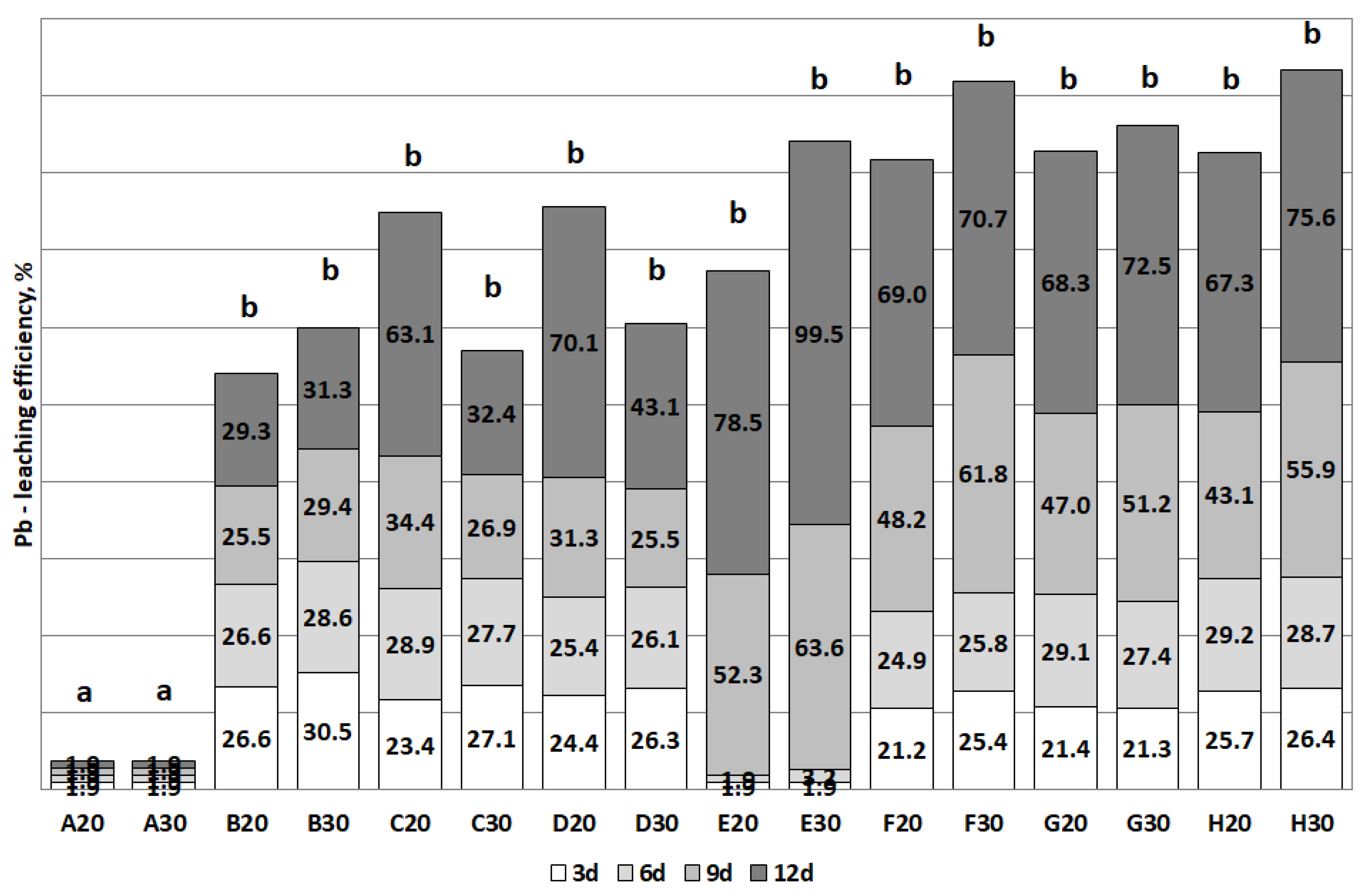
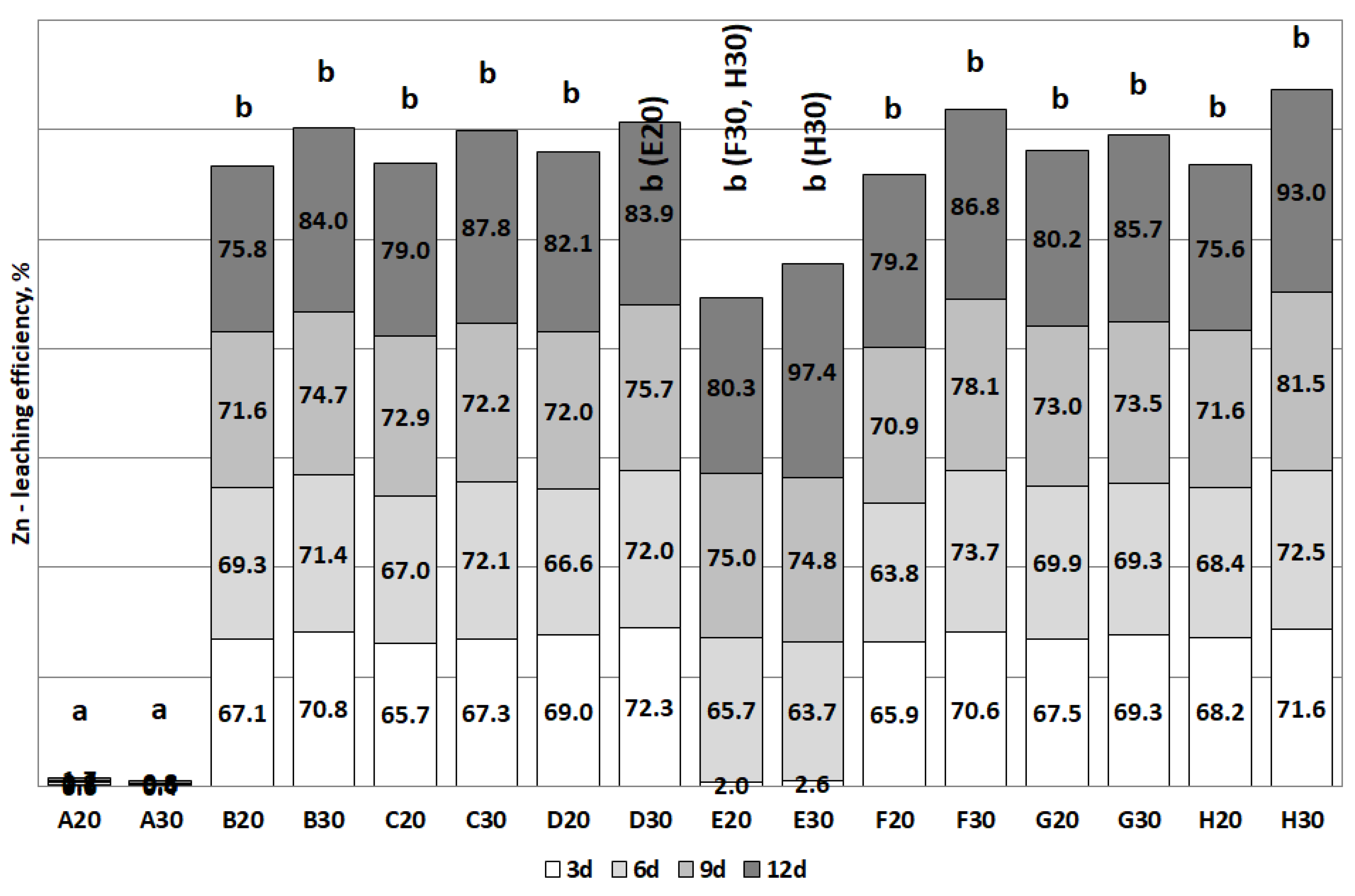

| Index | Units | Value |
|---|---|---|
| Dry solids (DS) | (g/L) | 8.9 ± 0.1 |
| Volatile solids (VS) | (g/L) | 5.0 ± 0.1 |
| pH | - | 6.9 ± 0.3 |
| Alkalinity | (mg CaCO3/L) | 571.7 ± 8.5 |
| Total Kjeldahl nitrogen | (mg N/L) | 721 |
| Carbon content | (%DS) | 27.80 |
| Hydrogen content | (%DS) | 4.41 |
| Nitrogen content | (%DS) | 4.84 |
| Sulfur content | (%DS) | 0.79 |
| Dissolved organic carbon | (mg C/L) | 73.9 ± 0.03% |
| Dissolved total Kjeldahl nitrogen | (mg N/L) | 25.2 |
| Dissolved ammonium nitrogen | (mg N-NH4+/L) | 2.2 |
| Metal | mg/kg | % DS |
|---|---|---|
| Al | 1110.4 | 0.1110 |
| Ca | 26,703.7 | 2.6704 |
| Cd | 20.5 | 0.0021 |
| Cr | 446.8 | 0.0447 |
| Cu | 135.4 | 0.0135 |
| Fe | 242,474.7 | 24.2475 |
| Mg | 2978.1 | 0.2978 |
| Mn | 738.7 | 0.0739 |
| Ni | 30.1 | 0.0030 |
| P | 15,796.9 | 1.5797 |
| Pb | 152.7 | 0.0153 |
| Zn | 5042.0 | 0.5042 |
| Treatment | pH Adjustment | Sulfur Addition, g | Incubation Temperature, °C | |
|---|---|---|---|---|
| A20 | WPS (135 mL) + water (15 mL) | - | - | 20 |
| A30 | 30 | |||
| B20 | WPS (135 mL) + water (15 mL) | 2.0 | - | 20 |
| B30 | 30 | |||
| C20 | WPS (135 mL) + water (15 mL) | 2.0 | 0.75 | 20 |
| C30 | 30 | |||
| D20 | WPS (135 mL) + water (15 mL) | 2.0 | 1.5 | 20 |
| D30 | 30 | |||
| E20 | WPS (135 mL) + A. thiooxidans (15 mL) | - | - | 20 |
| E30 | 30 | |||
| F20 | WPS (135 mL) + A. thiooxidans (15 mL) | 2.0 | - | 20 |
| F30 | 30 | |||
| G20 | WPS (135 mL) + A. thiooxidans (15 mL) | 2.0 | 0.75 | 20 |
| G30 | 30 | |||
| H20 | WPS (135 mL) + A. thiooxidans (15 mL) | 2.0 | 1.5 | 20 |
| H30 | 30 | |||
| Element | Incubation Temperature | |||
|---|---|---|---|---|
| 20 °C | 30 °C | 20 °C | 30 °C | |
| Combination (Efficiency, %) | ||||
| Combinations A–D | Combinations E–H | |||
| Al | C, D (>40) | B, C, D (>30) | H (>50) | E, H (>50) |
| Ca | B, C, D (>80) | C (>90) | E, G (>80) | E, H (>90) |
| Cd | D (>60) | D>20 | G (>60) | E, F, G, H (>60) |
| Cr | D (>80) | C, D (>50) | G (>80) | E, H (>90) |
| Cu | B (>70) | B, C, D (>70) | E, F, G, H (>60) | E (>80) |
| Fe | D (>80) | D (>30) | F, G (>80) | E, H (>90) |
| Mg | B, C, D (>70) | C (>80) | E, F, G (>70) | E (>90) |
| Mn | D (>90) | B, C, D (>90) | E, F, G, H (>80) | E, G, H (>90) |
| Ni | B, C, D (>70) | B, C, D (>80) | F (>80) | E, F, G, H (>80) |
| Pb | D (>70) | D (>40) | E (>70) | E (>90) |
| Zn | D (>80) | B, C, D (>80) | E, G (>80) | E, H (>90) |
Publisher’s Note: MDPI stays neutral with regard to jurisdictional claims in published maps and institutional affiliations. |
© 2020 by the authors. Licensee MDPI, Basel, Switzerland. This article is an open access article distributed under the terms and conditions of the Creative Commons Attribution (CC BY) license (http://creativecommons.org/licenses/by/4.0/).
Share and Cite
Kamizela, T.; Worwag, M. Processing of Water Treatment Sludge by Bioleaching. Energies 2020, 13, 6539. https://doi.org/10.3390/en13246539
Kamizela T, Worwag M. Processing of Water Treatment Sludge by Bioleaching. Energies. 2020; 13(24):6539. https://doi.org/10.3390/en13246539
Chicago/Turabian StyleKamizela, Tomasz, and Malgorzata Worwag. 2020. "Processing of Water Treatment Sludge by Bioleaching" Energies 13, no. 24: 6539. https://doi.org/10.3390/en13246539





